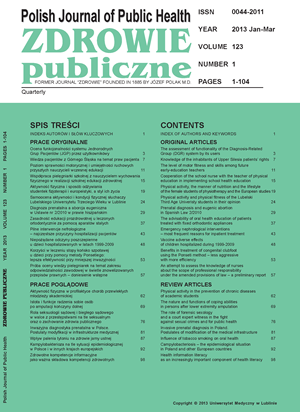The level of motor fitness and skills among future early-education teachers
DOI:
https://doi.org/10.12923/j.0044-2011/123-1/a.03Keywords:
teachers , motor performance, motor fitness and skillsAbstract
Introduction. The Polish law is giving the entitlement for conducting the physical education classes to both graduates of physical education, as well as the teachers of early education. The duty of teachers working with children is to provide knowledge, developing the skills and attitudes related to strengthening health of students. Physical education teacher by acting on the personality and the body of his pupils should also be a personality model for them. The teacher should have an appropriate level of the motor skills enabling to show the technique of performing the exercise.
Aim. The aim of this study was to examine the level of motor fitness and skills of teachers studying at postgraduate level in the field of integrated early education.
Material and methods. The study was performed in a group of 82 active teachers who instructed execution of 8 tests of motor skills and 12 exercises used in teaching kindergarten children and early education classes.
Results. The study showed the presence of the average and low-level motor skills in women. In 67% of the studied cases, women could not demonstrate basic motor skills to the children being taught by them.
Conclusions. Physical education classes for preschoolers and 1st-3rd graders should be conducted by experts in the field. Very low level of motor fitness and skills determined by the present study, it can be concluded that future early-education teachers are ill-prepared for carrying out such a responsible role
References
1. Osiński W. Antropomotoryka. Pozań: AWF; 2003.
2. Haywood KM. Life Span motor Development. Chapaign. Illinois: Human Kinetics Publishers, Inc; 1986.
3. Podstawski R, Borowska K. Motor fitness of school children from Ignacy Krasicki Primary School Nr 2 in Malbork depending on so¬cial and economic status. In: R. Muszkieta, W. Żukow, M. Napierała, E. Saks (ed). The status and development of regional sport and recreation. Bydgoszcz: Unia Akademicka & Wyższa Szkoła Gospodarki; 2010. p. 139-56.
4. Hirtz R, Starosta W. Sensitive and critical periods of motor co-ordination development and its relation to motor learning. J Hum Kin. 2002;(7):19-28.
5. National Association for Sport and Physical Education. Physical activity for children: A statement of guidelines for children ages 5-12. Reston: VA Author; 2004.
6. United State Department of Health and Human Services & Office of Disease Prevention and Health Promotion. Healthy Children 2010. Washington; 2002.
7. Council on Sports Medicine and Fitness & Council on School Health Active Healthy Living. Prevention of Childhood Obesity Through Increased Physical Activity. Pediatrics. 2006;(117):1834-42.
8. Church TS, Earnest CP, Skinner JS, Blair SN. Effects of Different Doses of Physical Activity on Cardiorespiratory Fitness Among Sedentary. Overweight or Obese Postmenopausal Women With Elevated Blood Pressure. JAMA. 2007;297(19):2081-91.
9. Piek JP, Dawson L, Smith LM, Gasson N. The role of early fine and gross motor development on later motor and cognitive ability. Hum Movement Sci. 2008;27(5):668-1.
10. Monyeki MA, Koppes LL, Kemper HC, et al. Body composition and physical fitness of undernourished South African rural primary school children. Eur J Clin Nutr. 2005;59:877-83.
11. Fiørtoft I. Motor Fitness in Pre-Primary School children: The EUROFIT Motor fitness Test Explored on 5-7-Years-old children. Pediatr Exerc Sci. 2000;12(4):424-36.
12. Tokmakidis SP, Kasambalis A, Christodoulos AD. Fitness levels of Greek primary schoolchildren in relationship to overweight and obesity. Eur J Pediatr. 2006;165:867-74.
13. Bishoff JA, Plowman SA, Lindenman L. The Relationships of Teacher Fitness to Teacher/Student Interaction. J Teach Phys Edu. 1988;7(2):142-51.
14. Podstawski R. Physical ability and opinions on health prevention among 1st year students of the university of Warmia & Mazury in Olsztyn in academic year 1999/2000. Olsztyn: UWM; 2006.
15. Melville DS, Cardinal BJ. Are overweight physical educators at a disad¬vantage in the labor market? A random survey of hiring personnel. Phys Edu. 1997;54:216-21.
16. Pagnano, K, Langley DJ. Teacher Perspectives on the Role of Exer¬cise as a Management Tool in Physical Education. J Teach Phys Edu. 2001;21:57-74.


